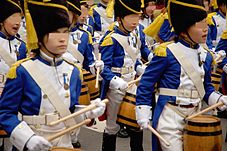
Tamborrada of Donostia (in Basque Donostiako Danborrada) is a celebratory drum festival held every year on January 20 in the city of San Sebastián, Spain. At midnight, in the Konstituzio Plaza in the "Alde Zaharra/Parte Vieja" (Old Town), the mayor raises the flag of San Sebastián. The festival lasts for 24 hours. Participants, dressed as cooks and soldiers, march in companies across the city. The celebration ends at midnight, when people congregate at the Konstituzio Plaza and the city flag is simultaneously lowered at various locations.[The last Carlist War in Spain took place between the end of the 18th century and the Second Carlist War (Literal translation from Catalan/Spanish: The War of the Matiners or Madrugadores) (1846-1849) and the Third Carlist War (in Spanish: Tercera Guerra Carlista) (1872–1876). As a walled military stronghold, the city of San Sebastián was subject to heavy property damage due to military activity, sometimes with dire consequences. This was especially true during the Siege of San Sebastián (1813), in which international powers (Spain, France, Great Britain, and Portugal) were involved. The festival is said to originate from the custom of locals using buckets and hardware from the water pump to mock the soldiers stationed in the city by aping their daily procession from the San Telmo headquarters to the Main Gate at the city walls ("Puerta de Tierra"). The comic procession in carnival mood may have developed into a youth music group, the Carnival of Donostia, started on the 20th of January, followed by the (Donostia/Caldereros|Caldereros) at the beginning of February. The war caused between 7,000 and 50,000 casualties.:107
In the early days, the procession also heralded the ox run event, held on the same day. At this stage, the members of the procession dressed in everyday clothes, as they had not adopted uniforms yet.The procession further developed when local tradesman Vicente "Txiki" Buenechea donated barrels to be used as drums. In 1881, unused military outfits were discovered in the San Telmo headquarters. These were donated to the council, which in turn gave them to the Union Artesana club for use in the Tamborrada. Other sociedades gastronómicas ("gourmet clubs") joined the Union Artesana in following years, thus expanding the festival attendance.:110
According to an urban legend, a baker was fetching water from a fountain during a drought in San Sebastián in 1720. As he began to sing, local women around him started pounding on their water basins to accompany him. To his surprise, the water kept on flowing and they kept on drumming with glee. Soon a crowd gathered. As the legend has it, there has not been a drought ever since, nor has the music ever stopped.In 1861, local musician Raimundo Sarrieguicomposed the occasion's iconic marches, including the "March of San Sebastian",:110 which caught on and gained popularity. Other works of his include "Erretreta", "Tatiago", "Diana" and "Iriyarena." Additional pieces have been added more recently. The traditional lyrics sung to the marches were composed by local writer Serafin Baroja.
Adults usually have dinner in sociedades gastronómicas ("gourmet clubs"), which provide elements of the procession, and traditionally admitted only males. Even the strictest ones now allow women on the "Noche de la Tamborrada". They eat sophisticated meals, mostly composed of seafood (traditionally elver, now no longer served due to its exorbitant price) and drink the best wines.
Depending on the time the company is marching, parade-goers take to the streets and are sometimes offered drinks between the musical performances. Nowadays the Tamborrada is made up of mixed sex companies for the most part, while proportions may vary a lot from one to the other. For "Donostiarras" this is the most celebrated festival of the year. These drummer groups often have marching bands playing along with them.
After hearing drums all night, children wake up with a version of the Tamborrada for children. They dress traditionally as soldiers from Napoleonic times and march around the city. Children from all the schools of San Sebastián march that day. They wear costumes that usually represent a particular country (such as England, Germany, or Romania). More recently, the parade has been pushed back to days before the festival proper, thus Children's Tamborrada is the first activity of the festival. 2015 marks the 54th anniversary of the Children's Tamborrada, which launched in 1961 to promote the cultural legacy of the festival to the younger generations. A repeat performance is held at noon of the festival day. 52 contingents from schools in the city join the celebrations beating their snare drums while honoring the heroes of the defense of the city and its patron.
No comments:
Post a Comment